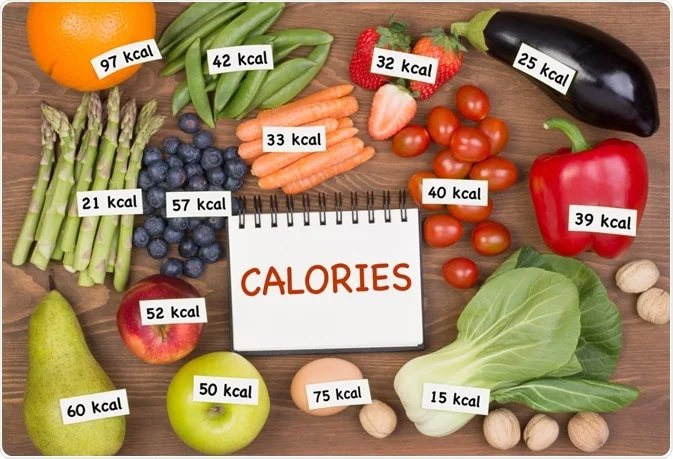
The number of calories we need to eat all depends on what we want to achieve, our body weight and how active we are during the day. Going more into detail, we would also consider our gender, age and height.
There will be loads of different formulas you could use to calculate your caloric requirements. Remember, though, that this is only an estimation. Once you know your number, you need to see how it works and adjust it accordingly.
Before we even start, we need to go through the basic terminology:

There are different formulas to calculate the calories. I have been using the Harris-Benedict formula for a long time now. Let’s present this one then.
Calculating BMR using Harris-Benedict (for kg and centimetres)
Men: 66 + (13.7 x body weight in kg) + (5 x height in cm) – (6.76 x age in years)
Women: 655 + (9.6 x body weight in kg) + (1.8 x height in cm) – (4.7 x age in years)
Calculating BMR using Harris-Benedict (for lbs and inches)
Men: 65 + (6.2 x body weight in lbs) + (12.7 x height in in.) – (6.76 x age in years)
Women: 655 + (4.3 x body weight in lbs) + (4.3 x height in in.) – (4.7 x age in years)
The above calculation is your BMR which stands for Basal Metabolic Rate. This is the number of calories you need to eat to survive without doing anything. Literally just lying down on the sofa and breathing. We need to add our activity level, training, walking, working and generally doing things during the day to BMR
We need to multiply BMR by the activity factor. It is a range between 1.2 – 1.9
1.2 – little to no exercise/training now and then, a bit of walking
1.3 – light exercises (1-3 times per week) and a bit of walking (under 8000 steps a day)
1.4 – moderate exercises (3-4 times per week), more walking (over 8000 steps a day)
1.5 – harder exercises (4-5 times per week) and more walking (over 8000 steps a day)
1.6 – heavy exercises (6-7 times per week) and more walking (over 10000 steps a day)
1.7 – very heavy exercises (sometimes twice a day + extra heavy workout) and much more walking
(over 12000 steps a day)
Man, 90 kg body weight, 180cm height and 40 years old
Woman, 73kg body weight, 164 cm height and 40 years old
Man
BMR = 66 + (13.7 x 80kg) + (5 x 180cm) – (6.76 x 40)
66 + 1096 + 900 – 270.4 = 1791.6 kcal
BMR = 655 + (9.6 x 73kg) + (1.8 x 164cm) – (4.7 x 40)
655 + 700.8 + 295.2 – 188 = 1463 kcal
This is the Basal Metabolic Rate which we need to multiply by the activity factor.
Let’s say we do 3 resistance training sessions a week, plus 1h of cardio a week, and we do over 8000 steps a day. I would go for activity factor 1.4
Man
BMR x 1.4 = 1791.6 x 1.4 = 2508.24 kcal
Woman
BMR x 1.4 = 1463 x 1.4 = 2048.2 kcal
This is your maintenance level. Having this amount of calories, you should not lose or gain weight.
Step 2
Choose your deficit or surplus
Surplus
Adding 300 – 500 kcal (surplus) – you will be building muscle mass faster but also gaining some body fat
Deficit
Reducing 300 kcal or less – it is good for people who are already lean and got around 10% body fat on them.
Reducing 500 kcal – good for people who got the moderate levels of body fat
Reducing up to 1000 kcal – good for people who got high levels of body fat
Let’s say we are going for a 500 kcal deficit for man and 300 kcal for women
Man: 2508 – 500 = 2008 kcal
Woman: 2048 – 300 = 1748 kcal
In this case, a Man who wants to lose weight could start his journey with 2010 kcal and a Woman with 1750 kcal
Once you know your calories requirement, stick to it. Remember that this is just an estimation, and you need to watch how it works for you. If your goal is to lose weight, but you don’t lose anything within the first 2 weeks, and your waist size is still the same, you need to cut your calories a bit more or increase the output (exercises, cardio or simple being more active by doing more steps etc.).
On the other hand, if you are starving and don’t have the strength to carry on with your training, you should add at around 150 kcal and watch your body. This will work only if you control your calories and weight your food. You should weigh your food for at least the first 2-3 weeks to learn about the portion sizes you are consuming. Otherwise, you are just guessing, and it will take longer to reach your goal.
If you eat less than you need, you will lose weight. Consuming food which is reach in protein, fibre, vitamins, and minerals will make you reach your goals faster.
Be consistent, patient and stick to your plan, and you will be surprised how fast you can make the first changes in your body.
Alternatively, check the Calories Calculator on my website. Click the following link to get to the Daily Caloric Intake calculator
All the best
Coach Marcin